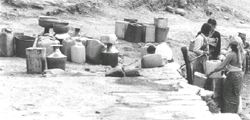Safe drinking water
 in order to provide safe drinking water to all rural areas during the Ninth Plan, the ministry of rural development has revised the guidelines for implementing the Rural Water Supply Programme (rwsp). This would involve exercising control on over-extraction of groundwater, more funds for repair and rehabilitation of infrastructure, increasing people's participation, reserving 20 per cent funds for the states and establishing stronger links with watershed development programmes. The main objective of the guideline is to ensure safe drinking water to all rural areas and to preserve the quality of water by institutionalising water quality monitoring and surveillance through a catchment area approach. The norms stipulate that 40 litres per capita per day (lpcd) for humans may be provided for drinking, cooking, bathing, washing utensils and ablution.
in order to provide safe drinking water to all rural areas during the Ninth Plan, the ministry of rural development has revised the guidelines for implementing the Rural Water Supply Programme (rwsp). This would involve exercising control on over-extraction of groundwater, more funds for repair and rehabilitation of infrastructure, increasing people's participation, reserving 20 per cent funds for the states and establishing stronger links with watershed development programmes. The main objective of the guideline is to ensure safe drinking water to all rural areas and to preserve the quality of water by institutionalising water quality monitoring and surveillance through a catchment area approach. The norms stipulate that 40 litres per capita per day (lpcd) for humans may be provided for drinking, cooking, bathing, washing utensils and ablution.
Related Content
- Compliance report by Andhra Pradesh on the presence of arsenic and fluoride in the groundwater of the state, 29/03/2024
- Guidelines for drinking-water quality: small water supplies
- Pollution of Adavikodu channel, an irrigation canal of river Godavari, Andhra Pradesh: APPCB report to the NGT
- 2023 Africa sustainable development report
- Performance audit of rural and urban water supply schemes: Government of Haryana
- Improving access to safely managed drinking water services: recommendations for G20 emerging economies
